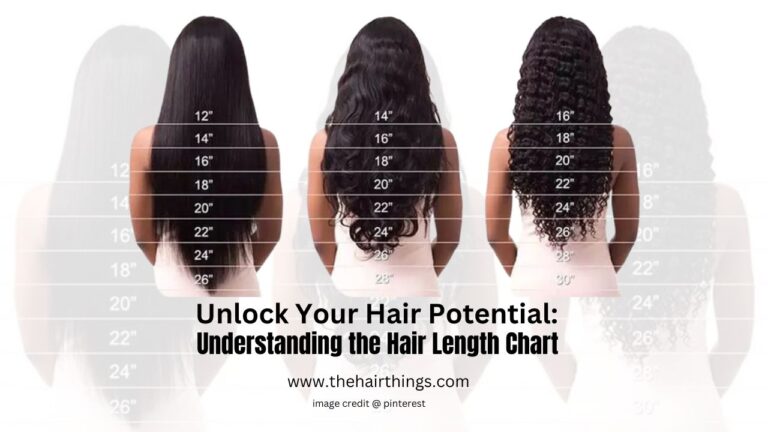Knowing the length and potential growth of your hair is essential when it comes to hair care. Knowing the hair length chart can serve as your compass while choosing a new hairdo or striving for a gorgeous mane. Together, we will explore the secrets of hair length and how it affects your styling decisions.
Understanding the Hair Length Chart:
Decoding the Basics
We don’t only mean the length of the individual hair strands when we discuss hair length. Rather, it includes the full process of hair growth, starting from the follicle and ending at the tips. This growth process is represented visually by the hair length chart, which divides hair into several stages according to its length.
Hair Length Categories
- Short Hair (0-6 inches): Pixie cuts, cropped styles, and shorter bobs fall into the category of short hair (0–6 inches). With so many styling options, short hair can give off a stylish but carefree vibe.
- Medium Length Hair (6-12 inches): 6 to 12 inches of medium-length hair gives the best of both worlds because it falls between short and long hair. This category showcases a variety of hairstyles, such as curls, waves, and updos, and ranges from shoulder-length cuts to lengthy bobs.
- Long Hair (12+ inches): Long hair radiates femininity and grace. There are countless options for styling, from loose locks to elaborate braids. To avoid split ends and breakage, long hair requires commitment to consistent trimmings and good maintenance practices.
Factors Affecting Hair Growth
Genetics, age, food, and general health are some of the variables that affect hair growth and length. While some people’s hair may grow more quickly on its own by nature, others could find it difficult to reach the length they want. Knowing these things can help you customize your hair care regimen to maximize health and development.
Tips for Healthy Hair Growth
- Nourish from Within: A balanced diet rich in vitamins, minerals, and proteins is essential for promoting healthy hair growth. Incorporate foods such as eggs, fish, nuts, and leafy greens into your meals to provide your hair with the nutrients it needs.
- Regular Trims: While it may seem counterintuitive, regular trims are crucial for maintaining hair health and preventing split ends. Aim for a trim every 6-8 weeks to remove damaged ends and promote growth.
- Gentle Handling: To prevent damage to the hair shaft and growth inhibition, stay away from harsh chemical treatments and excessive heat styling. When utilizing heated instruments, use heat protectants and go for mild, sulfate-free shampoos and conditioners.
- Scalp Care: Taking care of your scalp is essential for good hair development. Include scalp massages in your regimen to encourage follicle health and blood flow stimulation. In addition, think about treating any problems like dryness or dandruff on your scalp using professional treatments.
Conclusion:
Understanding the hair length chart and how it relates to your own objectives and preferences is the first step to unlocking the potential of your hair. You may get the length and style you want by using the right care methods and taking care of issues that hinder hair development. Recall that maintaining consistent and patient hair health is essential.
FAQs:
What is a hair length chart, and why is it important for hair care?
Knowing the hair length chart makes it easier for people to picture the many phases of hair growth, which helps them make decisions about styling, upkeep, and treatments.
How can I use the hair length chart to choose the right hairstyle?
Whether you want a long, medium, or short hairstyle, you may use the hair length chart to figure out what looks well on you right now.
What factors influence hair growth and length according to the hair length chart?
Hair growth and length are mostly determined by a person’s genetics, food, age, and general health. Customized hair care regimens that maximize growth potential are made possible by awareness of these factors.
What are some tips for promoting healthy hair growth based on the hair length chart?
Essential strategies for encouraging healthy hair growth include eating a balanced diet, having regular trims, avoiding heat style, handling hair gently, and placing a high priority on scalp health.
How often should I refer to the hair length chart to track my hair growth progress?
Periodically consulting the hair length chart—every few months, for example—enables you to track the advancement of your hair growth and modify your hair care regimen for best effects.








